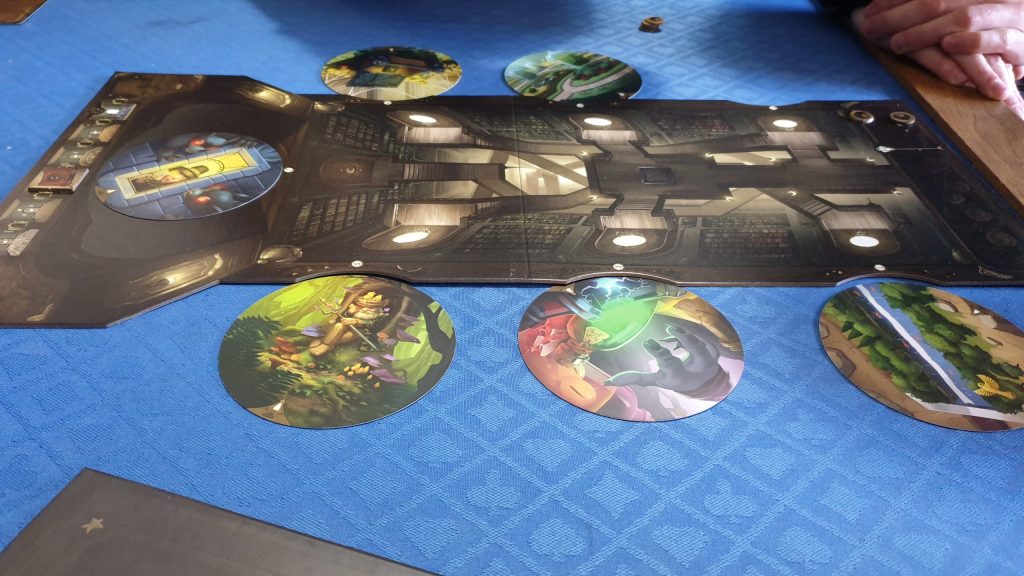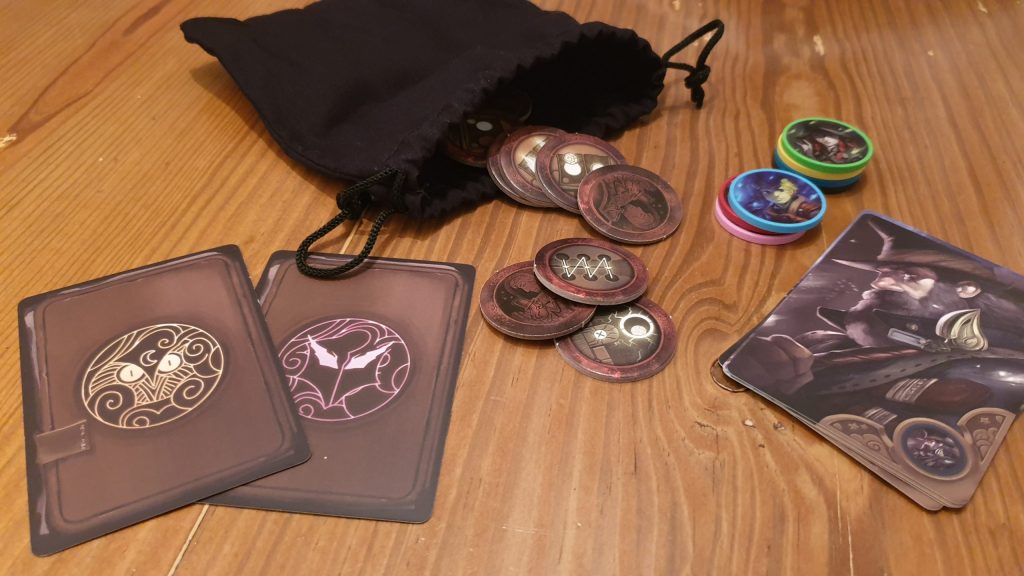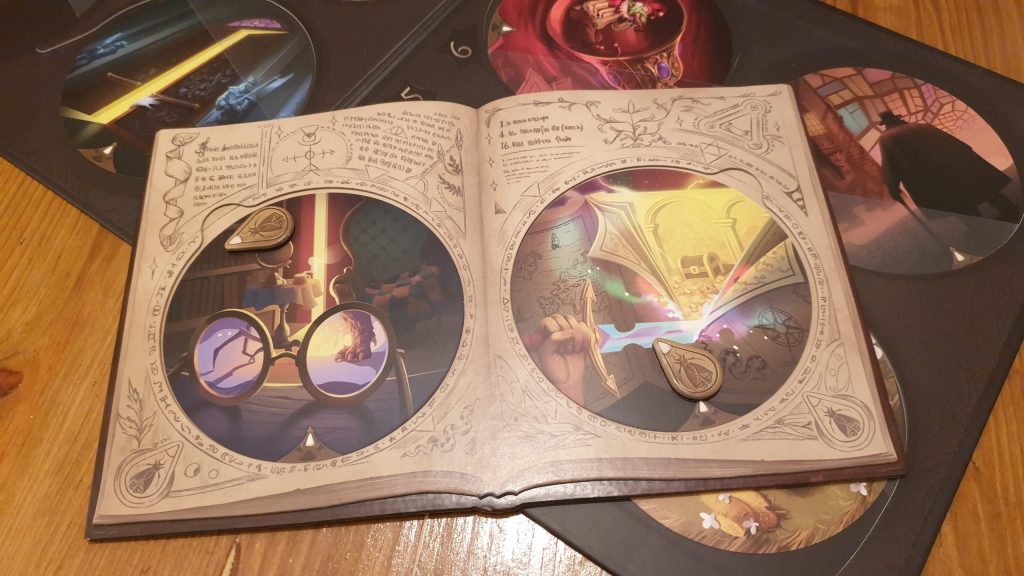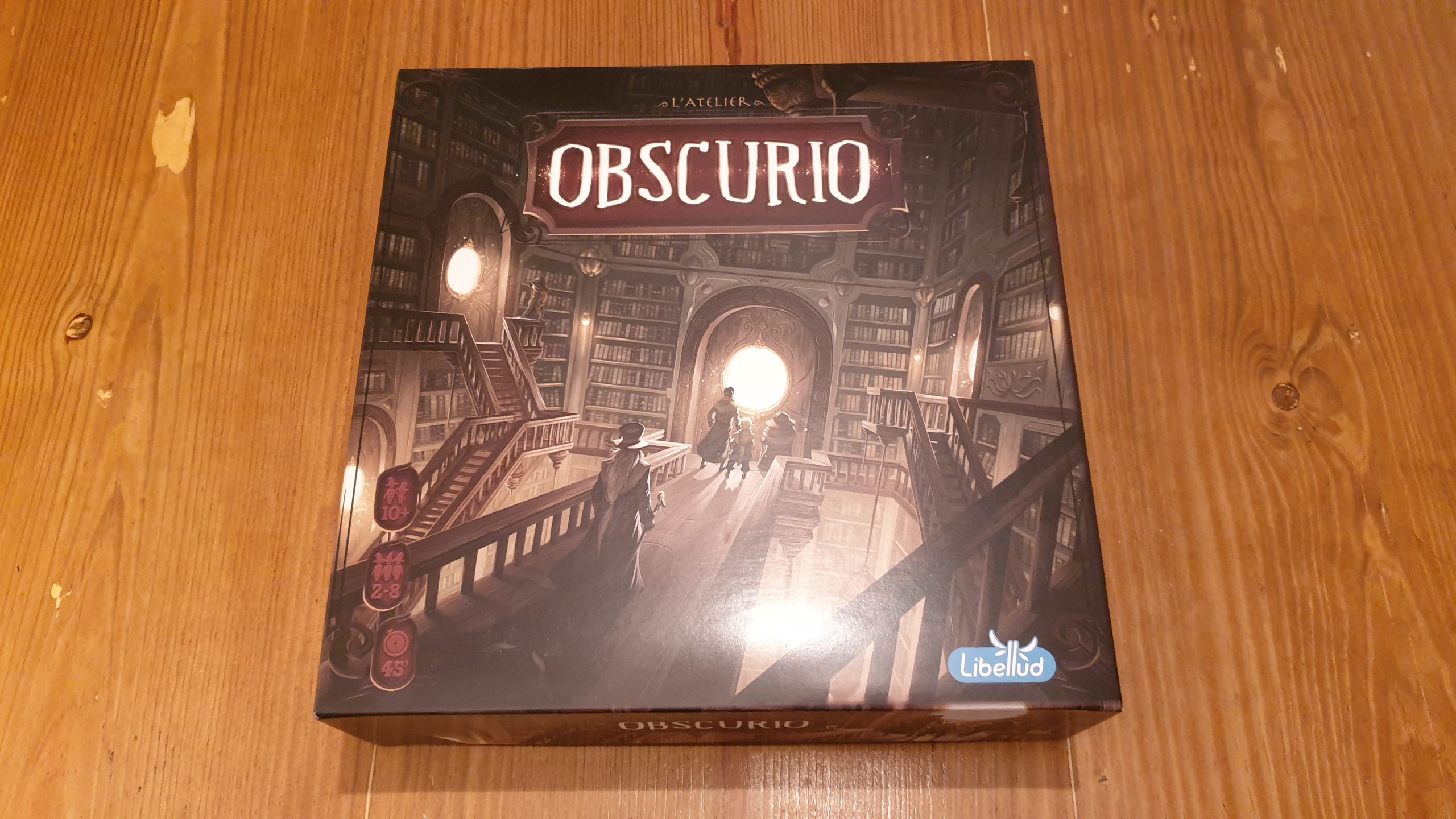Obscurio is the brand new deduction and hidden traitor game from publisher Libellud. Designed by L’Atelier, featuring artwork from Xavier Collette, the game is somewhat like the cooperative title Mysterium, though one of the players isn’t working with everyone else. Across the 45 minute game, 2 – 8 players will be finding their way through a sorcerer’s illusions, lead by a Grimoire. However, does this new twist work with the abstract illustrations? Let’s find out!
At the start of the game, one player must become the Grimoire, the book that holds the clues for the team. This player fills out the card holder with 8 illusion cards, ready for the traitor. The other players pick a character, though this truly only represents their colour not their role. The Grimoire player shuffles the loyalty role cards, so there is one traitor card and enough loyal wizard cards for the rest of the players. Each of the non-Grimoire players then gains one role card, secretly looking at it. Finally, the team of loyal wizards (including the unknown traitor) gets a number of Cohesion tokens. These are effectively life points, with the amount depending on the player count and chosen difficulty.
Each round works the same way, aside from a slight interlude to find the traitor towards the end of the game. At the start of the round the Grimoire draws a number of traps from the bag, with a minimum of one always included. These are always negative for the loyal players, ranging from a red filter being placed over the illusion cards on the Grimoire’s book to the illusion cards on the doors later in the round being shown one at a time.

Then, the riddle is created with the Grimoire secretly looking at the top illusion card – this becomes the card that the loyal wizards must locate. Replacing the two illusions in the book the Grimoire player then places two butterfly pointers. These either point at a page, suggesting it as a whole is the clue, or to an individual element in an illusion. The clues should help the loyal wizards later guess the correct illusion but also give the traitor some information. With everyone closing their eyes apart from the traitor, the card holder is opened so the traitor can select two illusions. These two are then combined with the actual illusion card of the round and by default 3 others. Shuffling these they are placed at the 6 doorways in the sorcerer’s library.
All the non-Grimoire players are then free to discuss which they think is the real illusion. This is somewhat against the clock, with additional traps earnt for the subsequent round each time the sandtimer is flipped. Only one player needs to go to the right door for the round to be a success – placing their player chip at the door they choose. However, for each not at the right door the team loses one of their Cohesion tokens.
If successful the team moves forward on the room tracker. The loyal wizards and the Grimoire need to complete the tracker to win. The traitor wins if they manage to stop this occurring. For the most part the next round then starts with a new illusion card and new traps. Once enough Cohesion tokens have been discarded it is time to vote on the traitor. Players simultaneously vote on whom the traitor is, with the player with the most votes having to flip their loyalty role card. If a loyal wizard is revealed two Cohesion tokens are discarded and another round of voting happens until the traitor is found. This doesn’t end the game but sees the traitor no longer able to choose a doorway – though they still get to pick the two traitor illusions.

The pacing of the game is generally fairly flowing, though there are a couple of sticky patches. These could trip up an analysis paralysis prone player, where a seemingly important decision needs to be made. The first part of this is as the Grimoire player choosing what to point towards as clues. At times the limitations provided to the Grimoire can actually make it easier, by reducing the options – though it potentially removes the best one. The other possible lull, when most players are unable to do anything, comes when the traitor is picking illusions. Again, it is a choice when only one player is involved. Get past these swiftly and the game bubbles along nicely.
Even with only a few cohesion tokens left Obscurio can come down to the wire. When a team doesn’t have enough tokens to split their guesses the choices become all or nothing. This does sometimes see the team instantly splutter and fail. There are occasions though when the team keeps making perfect deductions. Although this is after the traitor will have been revealed, the traitor isn’t just sat at the side. They still have input though picking two illusion cards, so they aren’t sidelined.
The deck of illusion cards is nicely cycled through. New cards come out for the real illusion and the Grimoire book, plus two new illusions are added to the card holder for the traitor to pick from each round. This stops the same images from being used and the same clues being given – which could have lead to stale gameplay. As with Libellud’s Mysterium or Dixit games the artwork that features in Obscurio can best be described as weird and wonderful. From Harry Potter like glasses on the floor of a magical library to a chess board of sorts each is surreal.

Every card features unique artwork. Yet, there is just the right amount of overlap between cards. Be it water being present, shades of colours or roughly what is going on in the scene there is plenty for the Grimoire player to use as hints – though most will still be vague. The quirk of Obscurio is that the cards are not large tarot-esque in shape. Instead, they are circular – as if they were what the players would see looking through the circle windows in the doors. In reality this makes no gameplay difference, and despite being of decent card stock it makes them a little awkward to shuffle.
The board itself has ample room for the poker chip like player tokens. This makes it easy to work out which doorway players a voting for at a mere glance. The cards fit around the edge, again with it being very clear which is at which door. The cohesion tokens are on the small fiddly side. These aren’t handled much, so it is less of a problem. They just don’t stack up well production wise when adjacent to the player chips.
While the sandtimer does the job, the Grimoire (the book itself) is the real stand out component. Being slightly heavier than just cardboard it is a magnetic board that the two butterfly pointers stick to, through the cards. This means the book can be passed around, without the risk or worry of the butterfly pointers moving, and wraps up the production quality of the title nicely.
Obscurio takes what players like from Mysterium, the weird and wonderful art and deduction, and adds a fun twist. There isn’t too much pressure on any of the roles. Even if the traitor is found out early they can still impact the game, shown by their ability to continue to play once fully outed by the loyal wizards. For those that don’t enjoy deduction from abstract artwork, seen in games like Dixit, this probably won’t be different enough for you. However, for even those luke warm on those types of games, the traitor role could make Obscurio the game for you.
(Editor’s Note: Obscurio was provided to us by Asmodee for the review. The game is currently available from local board game stores, find your local store here.)

